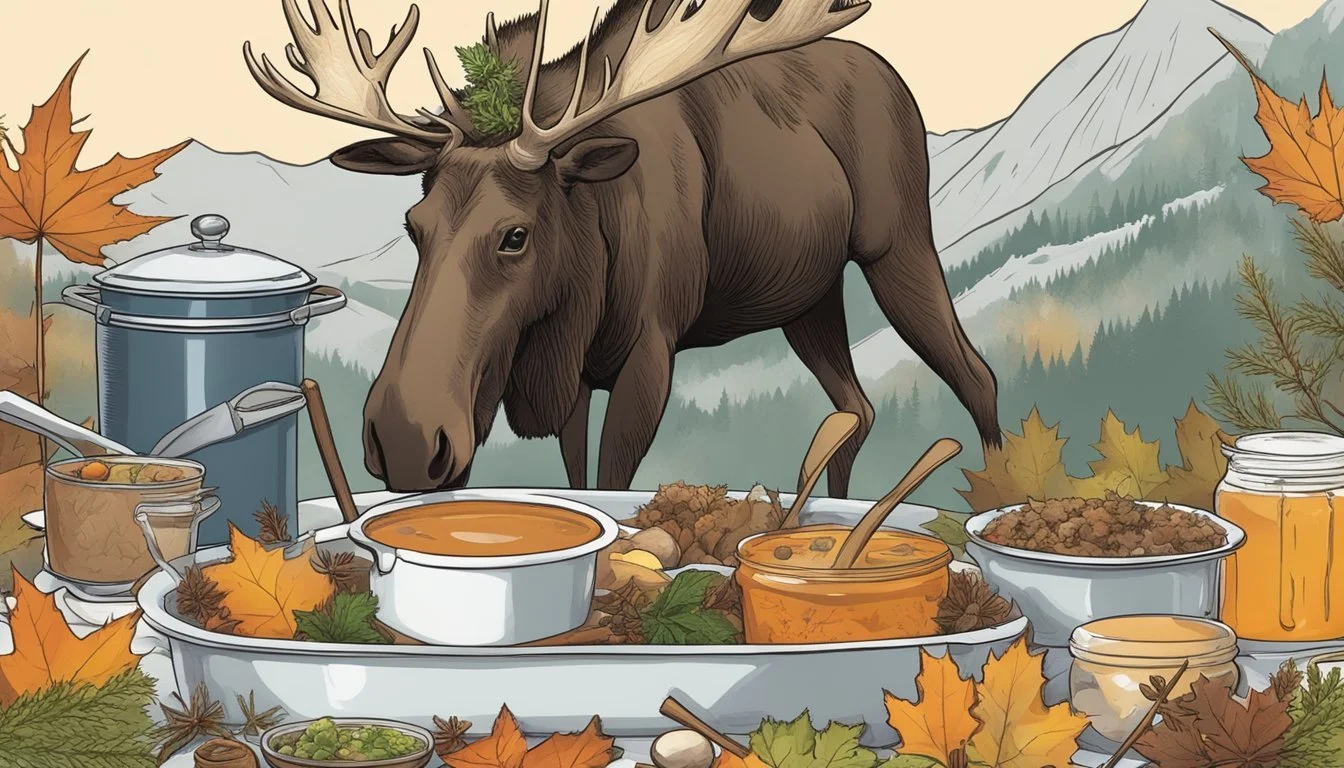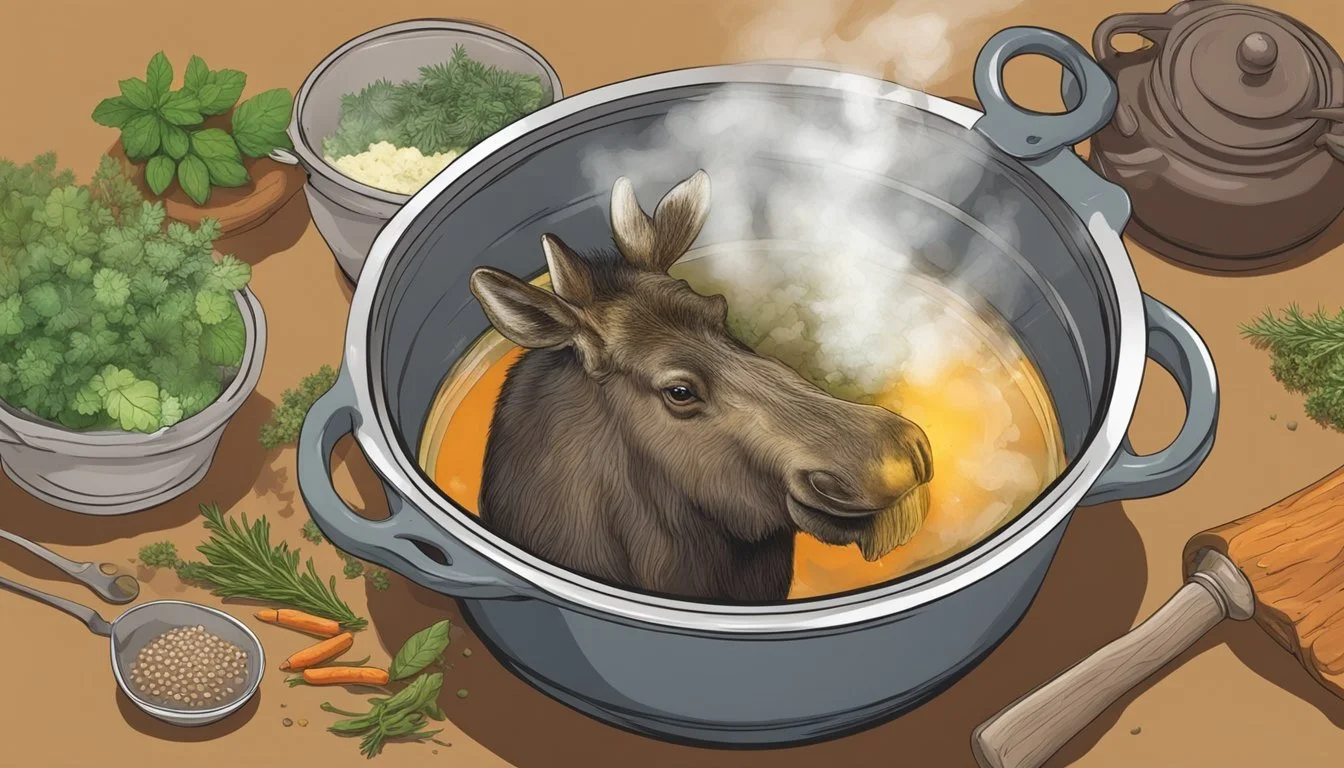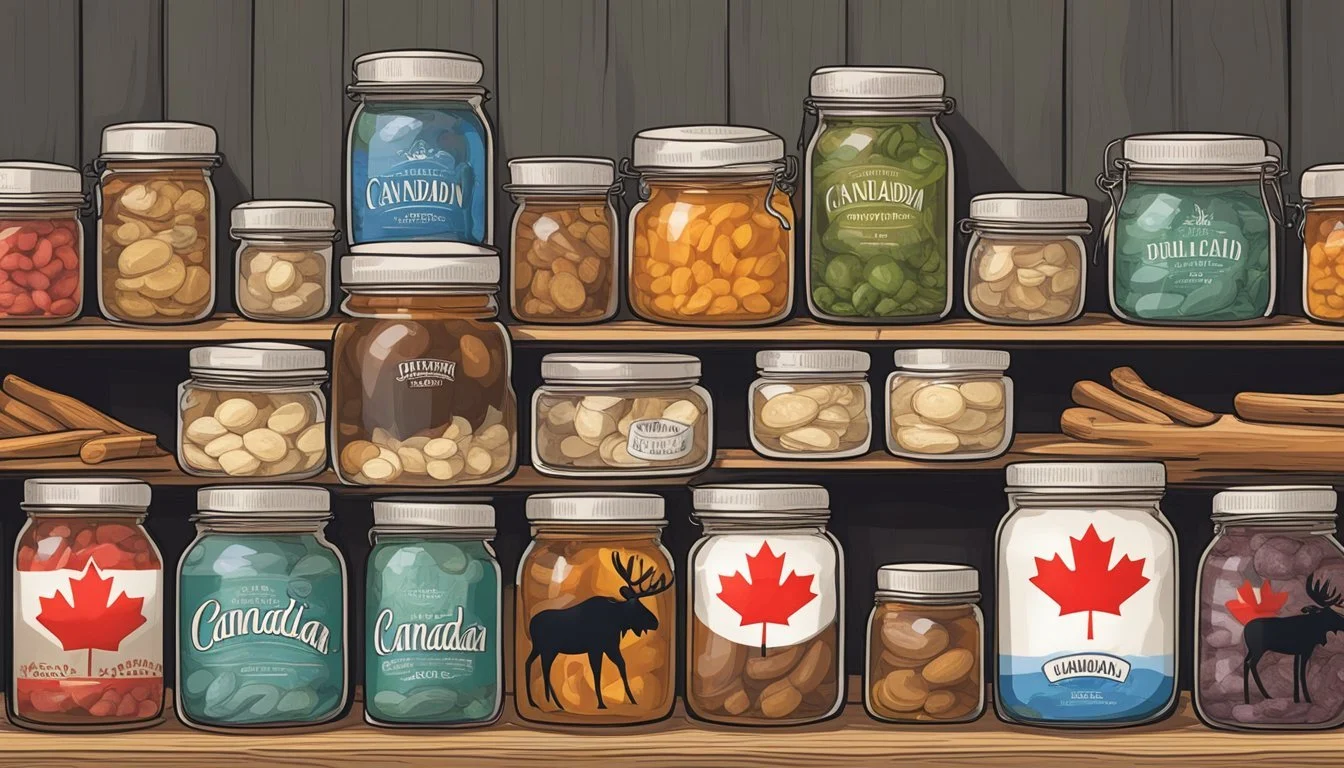Jellied Moose Nose Exploring Canada's Unique Culinary Heritage
Jellied Moose Nose is a traditional Canadian delicacy that has roots in the culinary practices of indigenous cultures in northwest Canada. Considered a unique dish, it is a testament to the resourcefulness of these communities and the use of local ingredients. The preparation of Jellied Moose Nose involves a process of boiling the moose's nose with ingredients such as onions, garlic, spices, and vinegar until tender. Once the cooking is complete, the nose is cooled, and the inedible parts like bones and cartilage are removed.
This specialty is closely related to European head cheese, yet distinct with its North American twist. The recipe, which was even included in a Canadian government cookbook in 1967, provided a method for those living in the wilderness to utilize every part of an animal, aligning with traditional beliefs of respecting the game by avoiding wasteful practices. Today, it remains a celebrated part of cultural feasts and continues to intrigue those with an adventurous palate.
Concocting Jellied Moose Nose is both an art and a method of preserving meat. After the initial preparation, the meat is arranged in a loaf pan and submerged in the cooking liquid. This mixture is then refrigerated, allowing the broth to gel and the flavors to meld. The resulting dish, sliced and served cold, might challenge the unaccustomed taste buds but offers a slice of Canada's culinary heritage that embraces the country's rich wildlife and the longstanding traditions of its indigenous peoples.
Historical Significance
Jellied moose nose is a dish steeped in tradition, tracing its origins to the indigenous cultures of the North American region. Its preparation and consumption reflect a deep respect for the local wildlife, showcasing an integral part of the subsistence lifestyle that is inherently linked to the cultural and historical fabric of the First Nations People and the Gwich'in.
Cultural Heritage
Indigenous Cultures in northern Canada, as well as in Alaska, have long passed down the tradition of making jellied moose nose. Not just a means of sustenance, this dish is a reflection of a profound reverence for the moose, an animal that plays a central role in the Northern Diet and culture. The First Nations People have preserved this culinary practice, allowing it to emerge as a distinctive aspect of the wider Canadian cultural mosaic.
Indigenous Practices
Hunting has been an essential practice among the Gwich'in and other Indigenous Cultures of the northern regions, with each part of the game used resourcefully to ensure nothing goes to waste. The moose's nose, often overlooked in contemporary cuisine, is carefully transformed into a jellied delicacy, embodying both culinary ingenuity and respect for the animal. This preparation underscores a historical reliance on natural resources and time-honored methods honed over generations.
Anatomical Insight
Understanding the anatomy of a moose is crucial for appreciating the jellied moose nose delicacy. The section provides detailed information about the moose's nose, how to select the best part for the dish, and a comparative look at moose anatomy versus other animals.
Moose Anatomy
The moose is the largest member of the deer family, and its nose forms a significant part of the head. The nose consists of a bulbous structure, which is divided anatomically into white meat (What wine goes well with white meat?) on the exterior and dark meat just below the surface. Moose meat, including that of the nose, is recognized for its unique flavor and texture, which differs greatly from common domestic meats.
Selecting the Nose
When selecting a moose nose for preparing the jellied dish, one should focus on the bulb of the nose, where the meat is most tender. The traditional process involves selecting a nose that feels firm to the touch, indicating fresh bone marrow within the nose, which is essential for the jelly's flavor and consistency.
Comparative Anatomy
The anatomy of a moose nose distinguishes it from other animals. Unlike livestock, the moose's nose is adapted to its wild habitat, offering a robust flavor profile. The white meat from the bulb of the nose and the dark meat provide contrasting textures and flavors that are highlighted when the nose is cooked and jellied, showcasing the unique nature of this Canadian delicacy.
Preparation Techniques
In crafting this unique Canadian dish, precision in preparation is key. Careful attention to the cleaning, cooking, and seasoning stages ensures a palatable outcome.
Cleaning and Skinning
The cook begins by thoroughly cleaning the moose nose. It's essential to remove all fur, which may involve singeing for a cleaner finish. The skin is then expertly removed, creating a clean piece of meat ready for cooking. Care is taken to also trim away any undesirable parts, ensuring that what remains is only the best for this dish.
Cooking Methods
The cleaned moose nose is placed in a large kettle of fresh water to boil. Cooks often add a mélange of aromatic ingredients to the water, including onion, garlic, and a curated selection of spices. The moose nose is simmered until tender, a process that can take several hours, during which the meat absorbs the flavors of the broth.
Stage: Boiling, Description - Moose nose in kettle with seasoned water., Duration - Until tender
Stage: Cooling, Description - Allow to cool in liquid overnight to enhance flavor absorption., Duration - Overnight
Seasoning Choices
The choice of seasoning can profoundly affect the final taste of the jellied moose nose. Typical choices include salt and pickling spice, providing a savory depth to the dish. A balance of these and other spices contributes to the complex flavor profile that defines the delicacy. Chefs are discerning in their use of seasonings to achieve the quintessential Canadian flavor.
Salt - Enhances overall flavor, pivotal for curing.
Pickling Spice - A blend that might include ingredients like cloves, bay leaves, and cinnamon, tailor-made to complement the meat's rich texture.
The Recipe
Jellied Moose Nose is a distinctive dish steeped in northern Canadian culinary tradition. A blend of uniquely regional ingredients and a methodical cooking process come together to create this classic delicacy.
Ingredients Breakdown
Moose Nose
1 Moose Nose: Fresh and thoroughly cleaned.
Vegetables & Seasonings
1 Onion: Sliced to enhance the broth's flavor.
4 Cloves Garlic: Crushed for a pungent aroma.
Assorted Spices: Pepper, and bay leaves to taste.
2 tbsp Vinegar: Gives the jelly its characteristic tang.
Step-by-Step Process
Preparation:
Begin by cleaning the moose nose thoroughly and placing it in a large kettle of fresh water.
Cooking:
Add the sliced onion, crushed garlic, spices, and vinegar into the kettle.
Bring the mixture to a rolling boil, then lower the heat and let it simmer until the moose nose is tender.
Cooling and Setting:
Once cooked, allow the pot to cool overnight, letting the flavors infuse and deepen.
Remove the moose nose, discard bones and cartilage, and slice the meat thinly.
Assembling the Jelly:
Lay the slices in a loaf pan and cover them with the seasoned broth.
Place the pan in the refrigerator until the broth sets into a gelatinous consistency.
Serving Suggestions
On Toast:
Serve the jellied moose nose thinly sliced atop slices of fresh, crusty bread.
Crackers Companion:
A spread over crisp crackers can offer a delightful texture contrast.
Adventurous Pairing:
For a unique twist, some might enjoy it as a topping on a traditional pizza, introducing a new fusion of flavors.
Variations of the Dish
While the traditional jellied moose nose dish is a testament to culinary heritage, variations have emerged both regionally and through modern culinary innovations.
Regional Twists
Regional variations of jellied moose nose often involve local herbs and spices to cater to the palate preferences of that area. In some parts of Canada, additional wild game such as beef or pork might be included to create a richer flavor profile. Heart meat, treasured for its texture, can also be a regional addition, drawing parallels to the European pâté or head cheese.
Modern Adaptations
Chefs seeking to adapt jellied moose nose to contemporary cuisine might experiment with the form, similar to sausage making, where the gelatin holds the spiced and flavored meat in an encased format. These modern adaptations could include the addition of exotic spices or the use of molecular gastronomy techniques to alter the texture and presentation of the dish.
Serving and Consumption
Jellied Moose Nose is traditionally served cold, sliced, and can be quite a conversational piece due to its unique texture and history. Now, let's examine the distinctive ways it's presented and consumed.
Traditional Presentation
The preparation of Jellied Moose Nose transforms it into a jelly-like dish that is cut and served similarly to a meatloaf. After the nose is boiled with spices and allowed to cool, it is arranged in a loaf pan—often a meatloaf pan—to settle and take shape. The loaf then congeals into a solid form due to the natural gelatins, resulting in a sliceable texture that is firm yet gelatinous.
Key elements of a traditional presentation include:
Loaf pan: Essential for shaping and setting the jelly.
Texture: Significantly firmer than a stew, the dish has a unique jelly-like consistency.
Eating Etiquette
In consumption, respect for the indigenous communities that cherish this dish is of utmost importance. It's typically sliced thin and can be eaten on its own or with a side of bread. Depending on personal or regional preferences, additional condiments may be added to complement the robust flavours of the meat.
Notable points about eating etiquette involve:
Respect: Being mindful of the cultural significance to indigenous communities.
Texture: Enjoyable in its jelly state, the dish provides an interesting sensory experience.
Culinary Context
In the realm of traditional fare, Jellied Moose Nose holds a distinguished place within Canadian cuisine. This unique dish, rooted in First Nations history, showcases a blend of flavors and textures, pairing the gamey nuances of moose with traditional pickling spices.
Pairings and Accompaniments
To complement the distinct taste of Jellied Moose Nose, which echoes the wild game flavor with a hint of corned beef, chefs often serve it with a variety of sides that enhance its rich profile. Common accompaniments include:
Crusty bread: To balance the dish's texture
Root vegetables: Such as carrots and potatoes for heartiness
Pickled items: Including beets or cucumbers to offset the richness
These pairings help to harmonize the flavors, ensuring a rounded culinary experience.
Comparative Delicacies
In comparing Jellied Moose Nose to other meat-based delicacies across cultures, one can draw parallels to:
European head cheese: Both use parts of the head (like the jaw and lips) but head cheese often includes other parts too, such as feet and hips.
Pig's trotters: Similar in usage of often overlooked parts (toes and feet), both dishes present a case for nose-to-tail eating.
These comparisons illustrate a global appreciation for utilizing all parts of an animal, which optimizes resources and honors traditional food practices.
Health and Nutrition
The consumption of jellied moose nose brings to the table a unique blend of traditional Arctic cuisine and nutritional aspects. Particularly, it offers protein content alongside certain dietary considerations necessary for those looking to include it in their diets.
Protein Content
Jellied moose nose is a significant source of animal protein, which is essential for muscle repair and growth. The exact protein content can vary based on the preparation method, but as a game meat, moose offers a comparable protein profile to other wild game meats from the wilderness of Northern Canada.
Dietary Considerations
Jellied moose nose is not widely recognized for its health benefits, but certain dietary attributes are notable:
Low-calorie: Moose meat is generally leaner than domesticated meats, making it a low-calorie option.
Fat content: Usually low in fat, particularly saturated fats, which could make it a suitable choice for heart-healthy diets.
Cholesterol: Game meats often contain less cholesterol compared to domesticated animals, potentially lowering the risk of heart diseases.
People with specific nutritional requirements should consider these factors when incorporating jellied moose nose into their diet. It is also important to prepare and consume this dish in moderation due to its unique composition and origins in traditional nutrition practices of the Arctic region.
Preservation and Storage
Jellied moose nose requires proper refrigeration to maintain its unique texture and flavor. Proper storage is essential to prolong the delicacy’s shelf life, ensuring it remains a savory treat.
Refrigeration Needs
Refrigeration is crucial for jellied moose nose since it relies on chilled temperatures to solidify the jelly. After cooking, the moose nose pieces need to be placed in a loaf pan, covered with broth, and then refrigerated. Only when the broth has cooled down and solidified does the jellied moose nose achieve its characteristic textured jelly consistency. It is important that the temperature remains consistently cold, mirroring conditions similar to those used for preserving ham or other gelatinous meat products.
Shelf Life
The shelf life of jellied moose nose, when stored correctly, extends significantly. Once refrigerated and set, the jelly can be kept for several days. It should be noted, references such as Atlas Obscura highlight the importance of consuming it while fresh to appreciate its intended taste and texture. Signs of spoilage should be monitored closely to avoid consuming the dish past its prime.
In Popular Culture
The unique dish of jellied moose nose is not only a conversation starter; it has also made its way into various facets of popular culture, notably through media discussions and the occasional nod from high-profile personalities.
Media References
Jellied moose nose has had its share of attention in media, particularly within Canada where it’s part of culinary curiosities. The dish has been featured in CBC Yukon broadcasts, highlighting its cultural significance and preparation methods in Northwest Canada. Additionally, it has surfaced in unconventional food segments on travel and food programs.
Celebrity Endorsements
Famed culinary adventurer Andrew Zimmern mentioned jellied moose nose, noting its uniqueness as a North American delicacy. While it may not be in every celebrity chef's cookbook, those like Zimmern, who specialize in exploring traditional and local foods from around the world, have brought it into the spotlight, showcasing its place in Canada's gastronomic offerings. This has contributed to the dish being recognized beyond Canadian borders.
End Notes
This section provides insights into the cultural significance and informational resources for those interested in the making and history of Jellied Moose Nose.
Conservation of Tradition
Jellied Moose Nose is steeped in the heritage of indigenous Canadian cultures, particularly among the Gwich'in peoples. A Gwich'in Elder might regard this dish as not only a traditional food but also a symbol of self-sufficiency and a connection to the land. Parts of the moose head, meticulously prepared, are a testament to the resourcefulness of these communities, who utilize every component of an animal with respect and purpose.
Further Reading
For enthusiasts and culinary historians wishing to explore this subject in greater detail, the following resources can prove invaluable:
Books & Journals: Academic papers and culinary texts documenting traditional practices.
Online Articles: Websites providing recipes and the cultural context behind them.
Documentaries & Interviews: Visual media where elders and chefs share their knowledge on the dish's preparation and significance.











